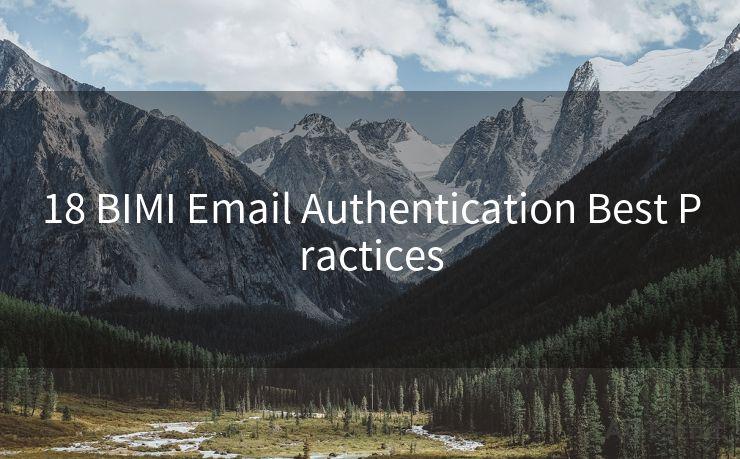18 BIMI Email Authentication Best Practices




In the digital marketing landscape, email remains a powerful tool for reaching and engaging customers. As such, ensuring your emails are properly authenticated is crucial for building trust and improving deliverability. Enter BIMI (Brand Indicators for Message Identification), a new email standard that allows brands to display their logos in recipient inboxes. Not only does BIMI enhance brand recognition, but it also boosts email engagement and, by extension, your SEO efforts. Here are 18 best practices for BIMI email authentication to help you optimize your Google search rankings.
1. Understand BIMI Basics
Before implementing BIMI, it's essential to understand its fundamentals. BIMI is an email authentication protocol that allows senders to display their brand logo in the recipient's inbox. This visual cue increases trust and engagement, leading to higher open and click-through rates.
2. Verify Your Domain
To use BIMI, you must first verify your sending domain. This process involves adding specific DNS records to prove ownership and control of your domain.
3. Set Up DMARC, SPF, and DKIM
BIMI works in conjunction with DMARC, SPF, and DKIM, three other email authentication protocols. Ensure these are correctly set up before implementing BIMI.
4. Create a Recognizable Logo
Your logo should be simple, clear, and recognizable. Avoid complex designs that may not render well in email clients.
5. Optimize Logo Size and Format
For BIMI, use a high-resolution SVG format logo. Ensure it's the right size for clear display in inboxes.
6. Test Logo Display
Test your logo's display across various email clients and devices to ensure it appears as intended.
7. Monitor BIMI Implementation
Regularly check your BIMI implementation to ensure it's working correctly and making the desired impact.
8. Measure Engagement Metrics
Track key engagement metrics like open rates, click-through rates, and conversions to assess BIMI's effectiveness.
9. Link BIMI to Your SEO Strategy
BIMI can indirectly boost your SEO by increasing brand awareness and traffic to your site through email engagement. Ensure your emails contain links to relevant content on your website.
10. Maintain Brand Consistency
Ensure your BIMI logo and branding are consistent with your website and other marketing materials for a cohesive brand experience.
11. Educate Your Team
Train your team on BIMI and its benefits to ensure everyone is on the same page about its implementation and goals.
12. Stay Up to Date with BIMI Developments
As BIMI evolves, stay informed about new features and best practices to maximize its benefits.
13. Leverage BIMI for Reputation Management

A recognized and trusted brand logo in inboxes can enhance your brand's reputation, which can positively impact your SEO rankings.
14. Integrate BIMI with Other Marketing Channels
Align your BIMI strategy with your overall marketing plan, including social media, content marketing, and PPC campaigns.
15. Consider User Experience
Ensure your BIMI implementation enhances the user experience by providing a visually appealing and trustworthy email experience.
16. Experiment and Iterate
Continuously test and refine your BIMI strategy to find what works best for your brand and audience.
17. Monitor Competitors
Keep an eye on how your competitors are using BIMI and learn from their successes and failures.
18. Seek Expert Advice
If needed, consult with email marketing and SEO experts to ensure you're getting the most out of your BIMI implementation.
By following these best practices, you can effectively use BIMI email authentication to boost your brand's visibility, engagement, and, ultimately, your SEO rankings. Remember, consistency, testing, and iteration are key to success with any new marketing initiative, including BIMI.




🔔🔔🔔
【AOTsend Email API】:AOTsend is a Managed Email Service for sending transactional emails. Support Email Types: reminders, authentication, confirmations, notifications, verification codes, invoices, password resets, account activations, billing statements, two-factor authentication (2FA), and one-time passwords (OTP) emails, etc. $0.28 per 1000 Emails. 99% Delivery, 98% Inbox Rate.
You might be interested in:
Why did we start the AOTsend project, Brand Story?
What is a Managed Email API, How it Works?
Best 25+ Email Marketing Platforms (Authority,Keywords&Traffic Comparison)
Best 24+ Email Marketing Service (Price, Pros&Cons Comparison)
Email APIs vs SMTP: How they Works, Any Difference?
Scan the QR code to access on your mobile device.
Copyright notice: This article is published by AotSend. Reproduction requires attribution.
Article Link:https://www.mailwot.com/p6863.html



